A post by Ovi at peakoilbarrel
To all of our participants, I wish you a Happy, Healthy and Prosperous New Year.
All of the oil (C + C) production data for the US state charts comes from the EIAʼs Petroleum Supply monthly PSM. After the production charts, an analysis of three EIA monthly reports that project future US production is provided. The charts below are updated to October 2020 for the 10 largest US oil producing states.
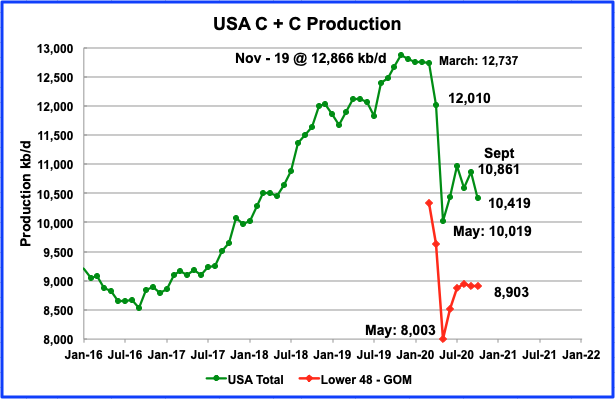
Octoberʼs US production decreased by 442 kb/d to 10,419 kb/d from Septemberʼs output of 10,861 kb/d. Octoberʼs decrease was largely due to the GOM being shut due to hurricanes. This can be seen in the October onshore L48 production graph which has been essentially flat since July at 8,903 kb/d.
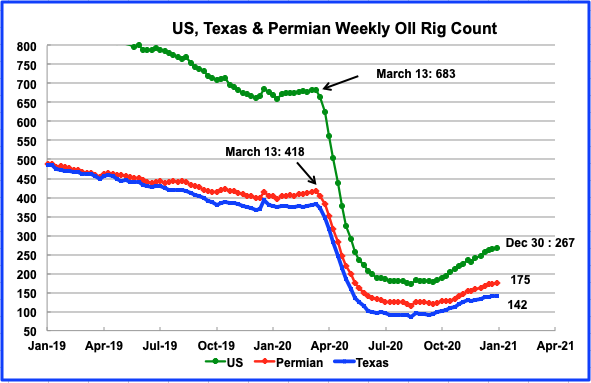
From July to September approximately 180 rigs were operating in the On-Shore L48. It will be interesting to see how the addition of 90 rigs from October to December affects production in the On-Shore L48 states. Note that WTI increased from $36 at the end of October to settle at $48.52 at the end of December, encouraging more drilling.
RANKING PRODUCTION FROM US OIL STATES

Listed above are the 10 states with the largest US production. These 10 accounted for 8,982 kb/d (86.2%) of US production out of a total production of 10,419 kb/d in October 2020.
Note that of all these 10 states, only New Mexico produced significantly more oil in October than in the same month last year and also on a MoM basis. On a YoY basis, US October production was down by 2,255 kb/d. Note that the production from these ten onshore states only increased by 13 kb/d in October.
Production by State

Texas production increased by 3 kb/d in October to 4,634 kb/d. During August and September, approximately 90 rigs were operating in Texas. This number of rigs is not sufficient to overcome the decline in Texas LTO fields. By end December 142 were operating.

October’s output was 1,218 kb/d day, an increase of 6 kb/d over September. During October 11 rigs were operational.
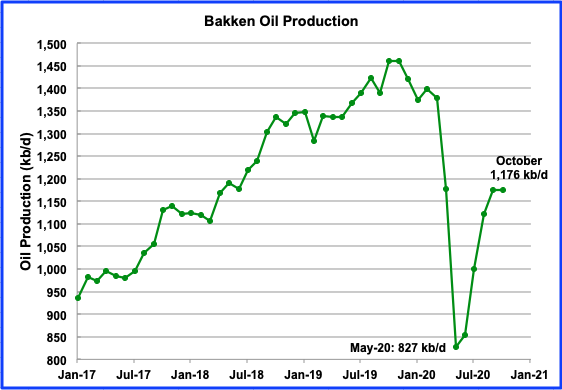
This chart shows Bakken production as reported by North Dakota’s Energy and Natural Resources Department. Of the 1,218 kb/d of output reported in October by the EIA, 1,176 kb/d are from the Bakken, a difference of 42 kb/d.

Octoberʼs New Mexico production increased by 57 kb/d to 1,081 kb/d. New Mexico has been adding rigs since late September as shown in the next chart.
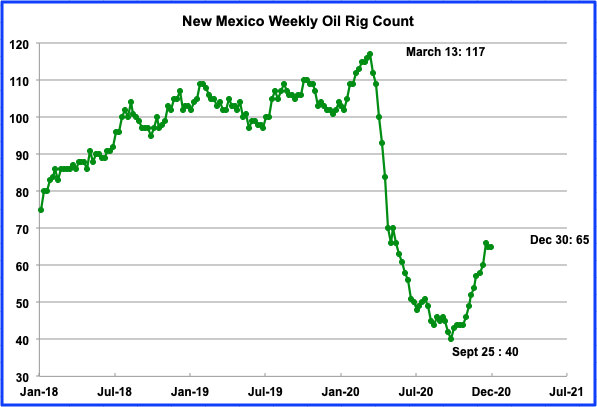
New Mexico had 40 rigs operating on September 25th after a high of 117 in March. By December 30th, 65 were operating.

After peaking in July at 476 kb/d, output has fallen to 421 kb/d in October. During September 11 rigs were operating and have gradually increased to 17 by the end of December. Will the increase in rigs stop the steady decline that started in July?

Coloradoʼs October output decreased by 24 kb/d to 394 kb/d. Colorado entered a steady decline phase after reaching its peak in November 2019. Colorado has added 2 rigs since September for a total of five at the end of December. Colorado’s declining production is related to low oil prices, the pandemic and new environmental regulations, according to this source.

Californiaʼs slow output decline continued in October. October’s production dropped by 5 kb/d to 374 kb/d. Since February, output has dropped by 53 kb/d for an average decline rate of 6.63 kb/d/mth.
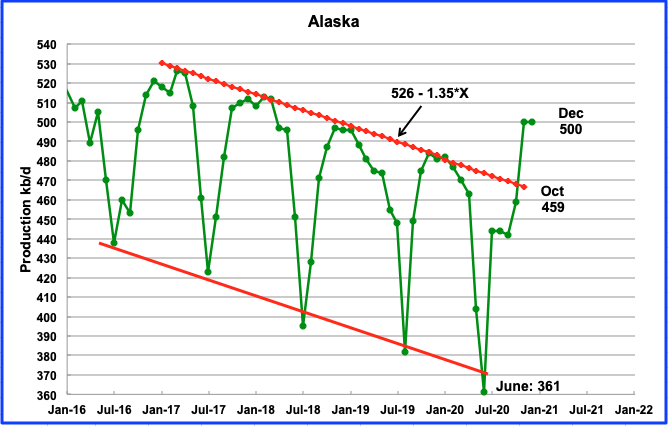
Alaskaʼs October output increased by 17 kb/d to 459 kb/d. The weekly EIA data indicates that both November’s and December’s output will be close to 500 kb/d and will break the red down trend peak decline line. The October to December increases may be associated with the start up of a new field which was announced in early 2020.
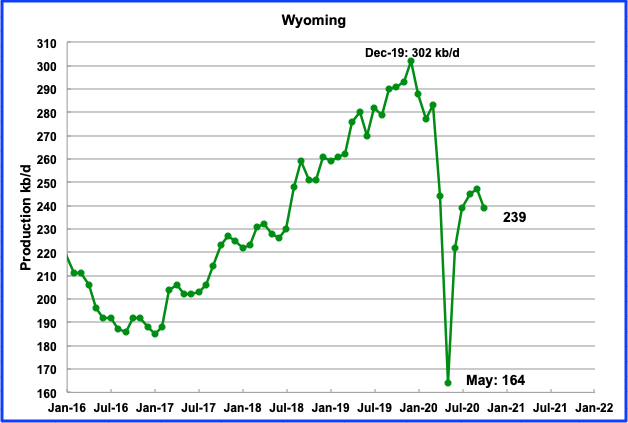
Wyomingʼs production in October decreased by 8 kb/d to 239 kb/d. Wyoming added 2 rigs during October and November for total of 3 at the end of December.

Louisianaʼs output dropped by 5 kb/d in October to 79 kb/d and appears to be in a steady slow decline. Louisiana added 2 rigs during October and November for total of 15 at the end of December. The 13 rigs operating in September were not sufficient to stop the decline.

October production dropped by 5 kb/d to 83 kb/d. Three oil rigs were in operation from October to December. None were operating from May to September.
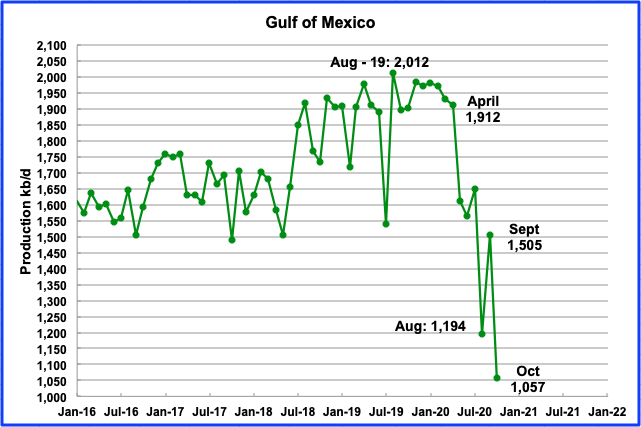
Production from the GOM fell to a new low of 1,057 kb/d in October, a drop of 448 kb/d due to hurricanes. August also saw a drop due to hurricanes. If the GOM were a state, its production would rank fourth behind New Mexico. Typically it ranks second after Texas, in the absence of hurricanes.
UPDATING EIA’S THREE OIL GROWTH PROJECTIONS
1) SHORT TERM ENERGY OUTLOOK (STEO)
The STEO provides projections for the next 13 – 24 months for US C + C and NGPLs production. The December 2020 report presents EIAʼs updated oil output and price projections out to December 2021.
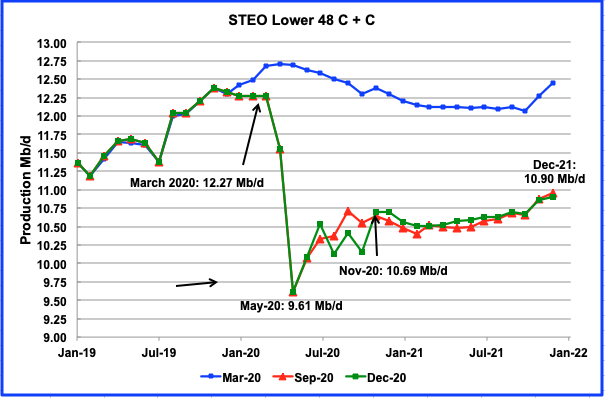
The December STEO output projection for the L48 states is very similar to the one that appeared in the September and October reports. The main difference is the reduced output from August to October 2020 due to hurricane disruptions. For October, the STEO is estimating L48 output to be 10.161 Mb/d. The EIA reported that actual October output was 9.96 Mb/d, lower by 0.201 Mb/d than the STEO estimate.
From November 2020 to February 2021, output is projected to be approximately 140 kb/d higher than was expected in the September report. Further, starting in November, production is expected drop to 10.51 kb/d in February and March before starting to increase.
By the end of 2021, output is expected to be 210 kb/yr higher than November 2020. Of the 210 kb/d, 180 kb/d are contributed by the on-shore L48 and it all emerges in the last two months of 2021. Between November 2020 and October 2021, there is no production increase.
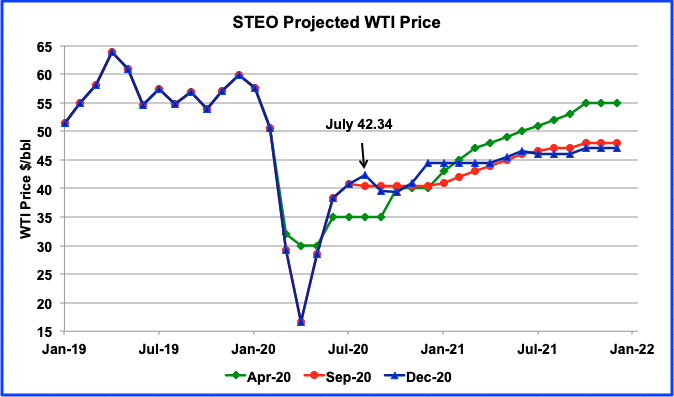
The December STEO is projecting a WTI price greater than $45/bbl from December 2020 to December 2021. However on October 30 the WTI futures contract settled at $35.79/bbl. Since then it has climbed back to above $45/bbl and settled at $48.52/bbl on Decemeber 31
2) DRILLING PRODUCTIVITY REPORT
The Drilling Productivity Report (DPR) uses recent data on the total number of drilling rigs in operation along with estimates of drilling productivity and estimated changes in production from existing oil wells to provide estimated changes in oil production for the principal tight oil regions. The following charts are updated to January 2021.
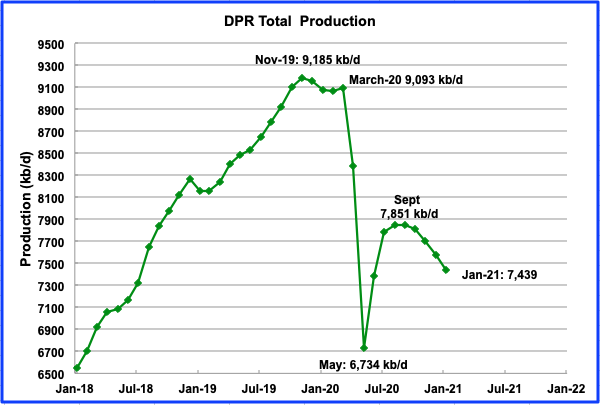
Above is the total oil production from the 7 basins that the DPR tracks. Note that the DPR production includes both LTO oil and oil from conventional fields.
According to the December report, the DPR basins oil output bottomed in May 2020 at 6,734 kb/d and recently peaked in September at 7,851 kb/d. The DPR is projecting output for January 2021 to be 7,439 kb/d, down 136 kb/d from December and down 412 kb/d from September. Since October, the average decline rate has been close to 125 kb/d/mth. According to ShaleProfile, the current number of horizontal rigs, close to 300, is not sufficient to increase LTO production in the US.
The contribution from three of the DPR/LTO basins is shown in the charts below.
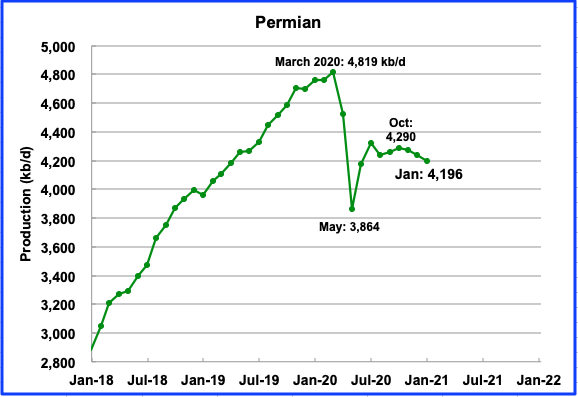
Permian output in January 2021 is projected to be 4,196 kb/d, down by 44 kb/d from December. Since the May low, the Permian added 456 kb/d by July primarily due to bringing shut-in wells back online. However output rolled over after the October high of 4,390 kb/d. The projected drop over the three months from October to January 2021 is 94 kb/d or 31 kb/d /mth.
The source for the Permian output rollover is given in the next chart.
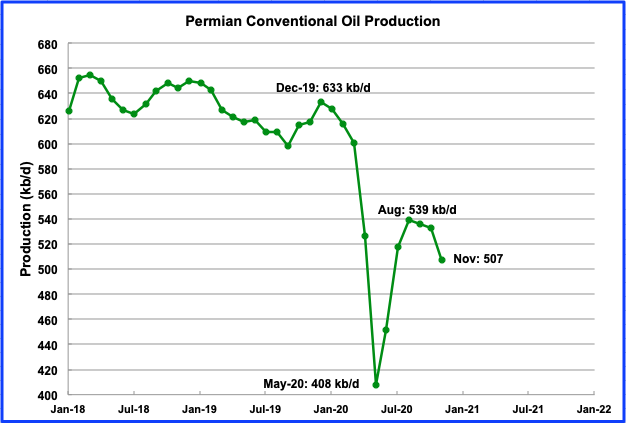
This chart shows the production of conventional oil in the Permian basin. It was generated by taking the difference between the DPR and LTO reports.
Conventional production in the Permian began to fall in August and took a sharper drop of 26 kb/d in November. The DPR output drop of 15 kb/d in November shown in the previous chart is a combination of the 11 kb/d increase in LTO production (shown in next section) and a 26 kb/d drop in conventional production shown above
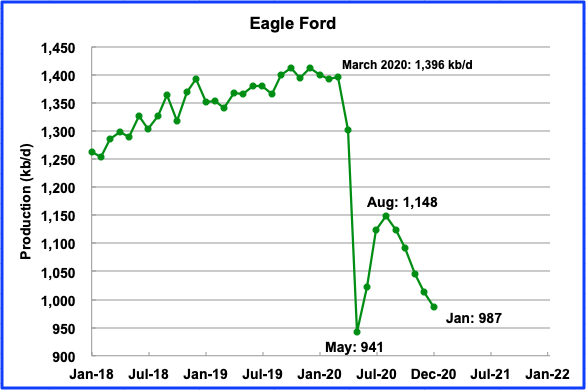
After bottoming in May, Eagle Fordʼs output reached a recent peak in August and then began to roll over. In January, EF output is projected to drop by 26 kb/d to 987 kb/d.
It should be noted that the November DPR expected December output to be 983 kb/d. The current December DPR revised up the December output to 1,013 kb/d, an increase of 30 kb/d.
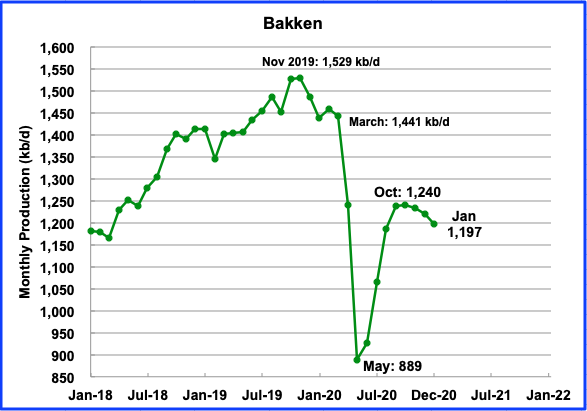
After the Bakkenʼs two big output drops in April and May, output began to bounce back in June. In January output is projected to be 1,197 kb/d a decrease of 23 kb/d from December. December’s projected output was revised up from 1,133 kb/d in the November report to 1,220 kb/d in the current December DPR, an increase of 87 kb/d.
3) LIGHT TIGHT OIL (LTO) REPORT
The LTO database provides information on LTO production from seven tight oil basins and a few smaller ones. The December report provides the tight oil production to November 2020.
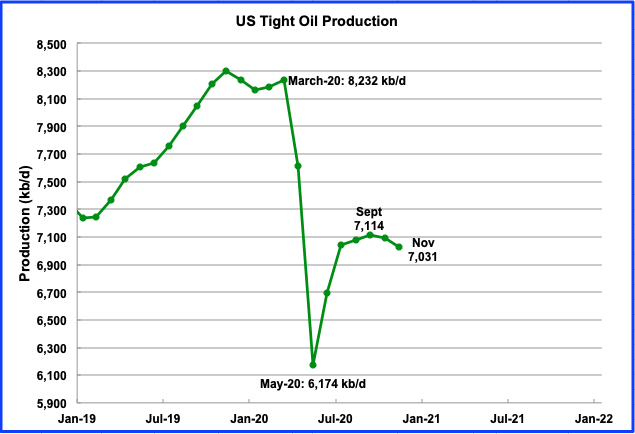
Novemberʼs LTO output is expected to decrease by 61 kb/d to 7,031 kb/d from Octobersʼs 7,092 kb/d. Note that the December report has revised down October’s output in the November report from 7,144 kb/d to 7,092 kb/d .

This table shows the relative importance of on-shore L-48 LTO to overall US output. In September, LTO output accounted for 65.5% of US output. October and November are STEO projections.
The 1,251 kb/d shown for the GOM in October, as projected by the STEO, actually turned out to be 1,057 kb/d.
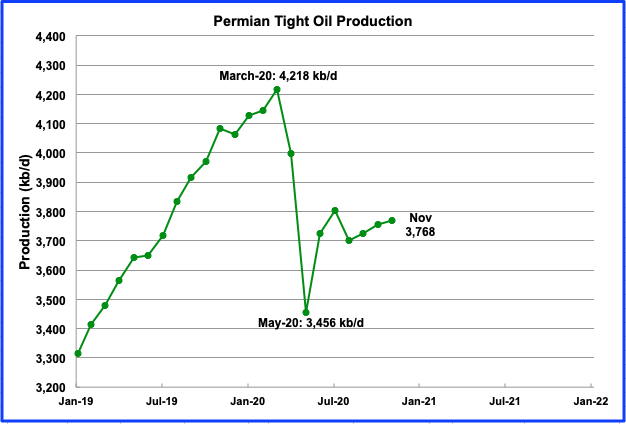
Permian LTO output in November is projected to be 3,768 kb/d, an increase of 11 kb/d from October.
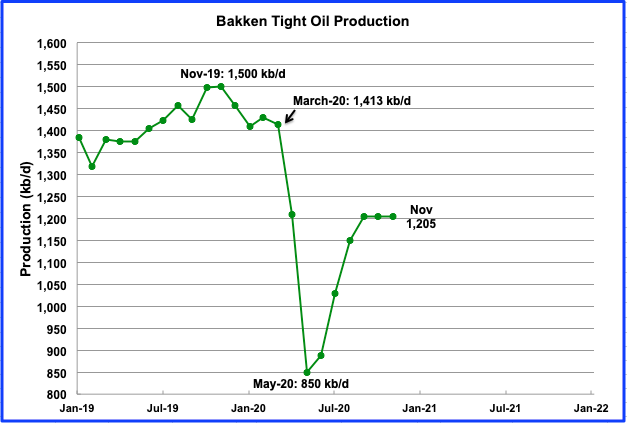
The Bakkenʼs November output has remained essential flat since September at 1,205 kb/d. In November and December, 11 rigs were operational.
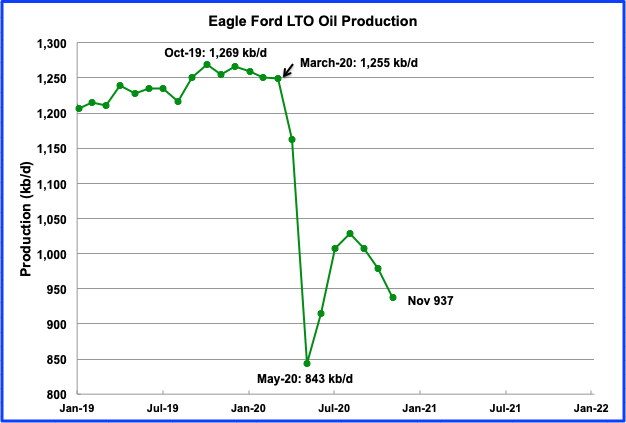
The Eagle Ford basin is expected to produce 937 kb/d in November, a decrease of 41 kb/d from October.
The number of operational oil drilling rigs in the EF has increased from 9 in September to 25 in December. How many operational rigs are required to keep output from falling in the EF basin? According to ShaleProfile, it “sees output falling below the May low in the coming months, unless activity is ramped up far more”.

Conventional oil is expected to increase in the On-shore L48 to 1,870 kb/d in November according to the STEO projection, an increase of 61 kb/d from September. Note that the September data point reflects EIA production data up to September.
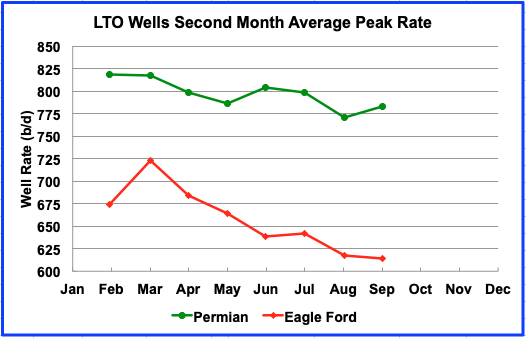
Above is shown the average monthly peak rate for the Permian and Eagle Ford wells in their second month. The well information was taken from the well quality tab in ShaleProfile. To clarify, the average shown for the Permian February wells is 818.5 b/d for 414 wells. The September “Second month average” is 782.5 b/d for all of the wells drilled up to September, 2,278 wells.
Note that a declining monthly average implies that the latest wells added have a lower average second month rate than the average of the previous wells.
I have done a reverse calculation to estimate the peak rate for the latest month. There are two ways to do it, use or not use the days in the month. The most realistic results come from not using the days in the month. For the Permian and EF wells, the last month peak rates are 915.5 b/d and 556.8 b/d respectively. The 915.5 kb/d rate for September is a significant change/increase, if correct.
DUCs
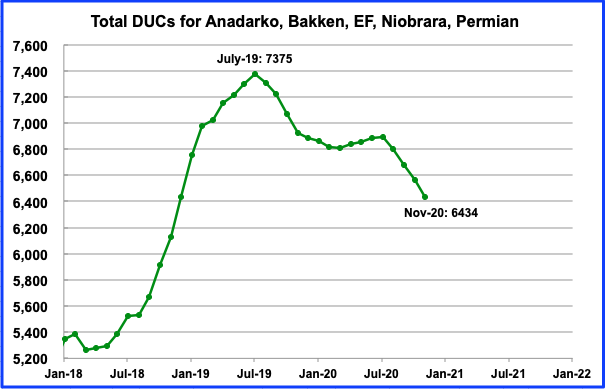
DUCs for the five primary oil basins have fallen almost continuously from the July to November for a total drop of 941.
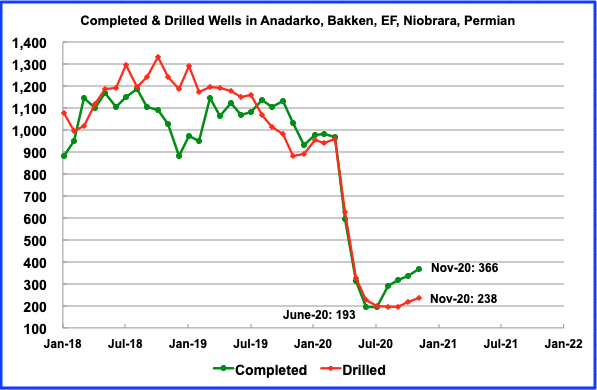
Since June, the number of monthly completed wells has increase by 173 to 366. The number of monthly drilled wells bottomed in August at 196 and has increased to 238 in November. The total number of completed wells from August to November is 1,309, which is a combination of 941 completed DUCs and newly drilled wells.
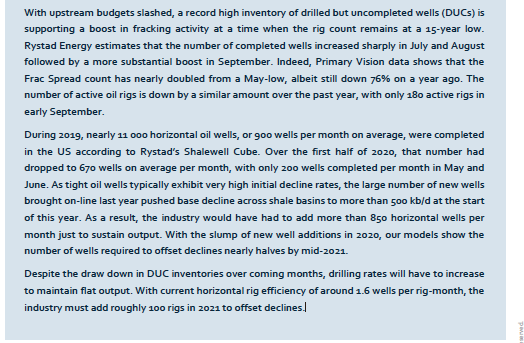
This clip came from the September IEA Oil Market report. The last statement corroborates the projection noted above by ShaleProfile. Interesting to note that one rig can drill around 1.6 wells per month.
World Oil Production
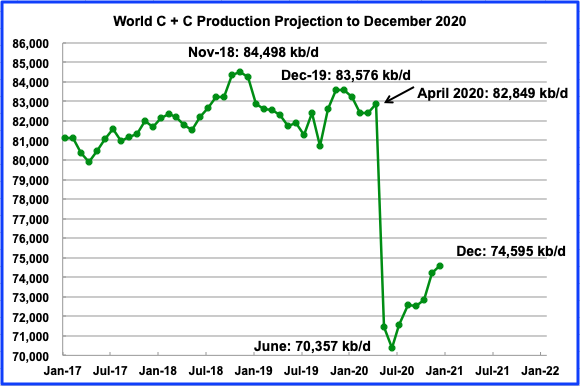
World oil production reached its lowest level in June at 70,357 kb/d. According to the EIA, production in September recovered to 72,519 kb/d. Of the 2,162 kb/d, 1,564 kb/d came from OPEC and 597 kb/d from Non-OPEC. Using the STEO, world oil production was projected to December when output is expected to reach 74,595 kb/d.
Hi Ovi,
Great post, thanks.
Happy new year!
An alternative way of looking at changes in Permian well quality is to consider cumulative output over a somewhat longer period than two months. The chart below looks cumulative well output for Permian basin for 2019 and 2020 wells by quarter of first flow.
Keep in mind there is some randomness to these numbers as month one output is simply a calendar month from the first to the last day of the month and well output from all wells that started producing that month. If all wells start producing on the first day of the month, then first month output is higher than a month where all wells start producing on the 30th day of the month, likewise month 2 output would be lower in the first case and higher in the second case (neither case is realistic of course), but the point is that the average well might have a day 10 average start in one month and day 20 another month and this will affect both month one and month 2 output. Using cumulative output smoothes out this effect to some degree and from that perspective may be a better measure. There are other random effects, some wells are just better than others, it is not always the best wells that get completed first, oil companies would like this to be the case, but the results are not usually predictable.
Chart below from shale profile at link below
https://shaleprofile.com/blog/permian-monthly-update/permian-update-through-september-2020/
Dennis
I was looking for another indicator that showed whether the efficiency gains over the past four years were coming to an end. The 2018 to 2020 cumulative graphs were already showing that the gains were slowing and in 2020 appeared to have stopped.
It was surprising to me when 2020 did not show up in the latest ShaleProfile “Well quality” chart. See attached chart. Considering that the peak rate was 595 kb/d in 2016, 810 kb/d in 2019 and 782 kb/d in 2020 was just one more indicator that the efficiency gains that occurred over the last four years were slowing and possibly coming to an end.
I plan to track that peak rate into 2021 to see what it does. What is not clear is whether the drop is related to a mix of new wells from sweet spots and DUCs that were finished but possibly of lower quality, i.e. not from the sweet spot areas, but were just cheaper to bring online.
As I noted in the post above, I was surprised when the peak rate for the second month peak rates for Permain wells drilled in September turned out to be 915.5 kb/d. It was a significant change/increase and I wondered whether it was correct. Time will tell
Ovi,
2020 may just be hidden by other years. Thinner line due to fewer wells. I would agree well quality for Permian has plateaued and for Eagle ford is decreasing. Too early to conclude the decrease has started in Permian as of 2020 in my opinion.
I have thought well quality would decrease next year in Bakken since 2013, eventually I may be correct 😉
Dennis
When you click on the year, the 2020 well data shows up. Below are two Permian examples and they show how I collected the data. One is for February and the other is for August.
Note the average for the Permian February wells is 818.5 b/d for 414 wells. For August, the “Second month average” is 770.6 b/d for the 2,091 wells drilled up to August.
August picture
Ovi,
look at well profiles from month of first flow.
I get the following for second month new well output for Jan 2019 to August 2020.
My guess is that a higher proportion of DUC completions dropped average 2nd month peak output from March to July 2020.
Chart below, click on chart for larger view.
Dennis
I did not see the option for month of first flow. I have looked at the data and not clear what is changing from month to month. I have looked at how the second month flow rate changes for the month of April when looked at on successive months, July, August and September. Attached are two charts that were used to collect this Permian data.
Why are there more wells showing up if the month of first flow for all these wells is April. Is it just a question of late reporting of the data in Texas. If it is late reporting, the data below gives an indication of the variability in the peak rate as new wells are added each month. Assuming that numbers below are averages, then the 52 wells added in August must have been low quality wells that came in at close to 400 b/d.
686.6*209 52*400 = 164,300. 164,300/261 = 629.5, the August average.
On the other hand, it could be that the April wells reported in August weren’t online for a full 50 to 60 days.
Rate Wells
July Update: 686.6 209
August Update: 629.4 261
Sept Update: 659.1 269
September
Ovi,
Enno updates his data at every report so that all months reported are as accurate as possible. My chart is based on the Permian data reported on the Shaleprofile blog on December 15. Earlier reports would have different data because there are constant revisions.
Note that “second month” wells might have been producing anywhere from 29 to 62 days total ( assuming no down time in the second month) if we account for the possibilty of a well being shut in due to production problems for up to 15 days in the second month, then there is a possibility the well might have produced anywhere from 16 to 62 days. This random variability becomes larger when there are fewer new well completions as was the case from Mat to August 2020 when fewer than 200 new wells were completed in the Permian basin each month (174,162, 199, 161) vs 941 new wells completed (470/month) in Jan and Feb 2020. Of the wells completed from May to August 2020 about 376 were from DUC inventory, about 54% of all wells completed over that 4 month period. In Jan and February 2020 only 6.2% of Permian wells completed were from the DUC inventory, a significant difference.
https://shaleprofile.com/blog/permian-monthly-update/permian-update-through-september-2020/
Comment at end of last thread I moved here
RASPUTIN
01/02/2021 at 4:18 am
I have followed the discussions on this site for a year but never commented before. To say the least I’m intimated by the minds that moderate or comment on this site but truly I have avoided getting my ass handed to me for any of a number of potential slights. However, on the subject of falling CO production, I couldn’t keep quiet.
For the past 30 years I have operated wells in CO and even participated in the early rulemaking hearings during the transition to the COGCC becoming the unrecognizable, anti-industry juggernaut that it has become. Please forgive the rambling, disjoint discourse but this is very, very personal.
I respectfully submit that when considering the decline in drilling/completion activity and production in CO, one should not simply rationalize these as the result of falling commodity prices and economic viability relative to other plays. Articles have hit the national energy sites over the last couple of years discussing the building draconian rules and regulations with more set to take effect on the 15th of this month yet none have ever looked at the scope and nefarious nature of what is going on there. For example, in 2018 a proposition was before the voters to have a 2,500 ft setback between new wells and occupied structures of every stripe and it was soundly defeated. The next year the state legislature went right around the voters to pass SB181 which implemented a setback of 2,000 ft. But SB181 didn’t stop there and has yielded a sweeping overhaul and “enhancement” of rules and regulations. A provision was made for counties to have some local authority in the permitting/regulatory process. When the smoke cleared, local control of well setbacks, which would have made sense, was disallowed yet county and municipal regulatory bodies popped up to add additional compliance hurdles instead. The Oil and Gas Act which established the governing body in the early 1950’s was stripped of one of its several mandates; that which promoted the production of oil and gas in CO. The mandate to protect correlative rights remains and the mandate to prevent waste has grown unrecognizably like the Andromeda Strain. Who would have known that the word waste was so rich and understated.
A few months ago on POB, a discussion popped up regarding methane emissions, monitoring, costs and, I believe, stripper well requirements. Perhaps a few more folks than Shallow Sand should buy wells and write the checks for compliance on that issue as for him, me and many others, the costs are not hypothetical or theoretical. While the comments were genuine they were ill-informed to say the very least. In CO, the CDHE air quality regs have exploded with the compliance goalposts moving yearly with overwhelming costs. Just 3 years ago, several hundred gassy oil wells and oily gas wells were left without a pipeline when Anadarko chose to abruptly shut down (and refuse to sell) the only pipeline accessible to the wells. The operators installed burners in order to still produce the oil resources. Now, they are not allowed and the wells, which only 3 years ago were very profitable, are slated for plugging should the operators have the money to do so. There’s a country mile’s difference between the volumes flared on a Permian well site and the sub stripper volumes burned in highly regulated combustors in CO but in CO they are treated equally.
On the comment of the goalposts moving yearly, I and many other operators have had conversations with inspectors where they admit that rules come out for enforcement at such frequency that they can’t keep track. If they can’t keep up, then how are we supposed to keep up. I haven’t spoken to a fellow operator that feels when compliance upgrades are executed it will be sufficient in the very near future and we all love getting those NOAVs and correspondence that tells you how heavy the state’s hammer is and where it’s positioned.
Honestly this is but a taste of the regulatory dysfunction in CO and I could ramble on for pages. And I might seem a whiner and a loser; maybe so. Strangely enough, there are scores of other operators in CO that must be as well. with many being run by people that I look up to. Many are long lived family companies, some are well financed investors and others are guys like me that have weathered numerous bust cycles without BK only to find out that you can’t fight the government. As many of you seem to have available resources and great intellects, I would challenge you to study CO deeply and see if the production numbers can be explained relative to other basins and opine as to where we are headed from a federal perspective. Think beyond BLM and CA regs and you will see CO way out front.
Thank you for the opportunity that you afforded me here.
Rasputin,
Thanks for the comment.
Sorry about the regulatory problems, I thought as far as tight oil output falling in the DJ-Niobrara, part of the explanation for falling output is lower wellhead prices in Colorado compared to West Texas. No doubt changes in regulations may be the bigger effect, I do not follow the news in Colorado closely, so my comment was likely wrong, sorry.
Do you have any idea what a typical full cycle capital cost is for a DJ- Niobrara tight oil well?
Found this
https://www.westwoodenergy.com/news/right-sizing-well-completions-in-the-rockies
It suggests about 5 million for drilling and completion for well with 10,000 foot lateral, maybe add another 1 million for land costa and other overhead for possibly a six million dollar well cost.
Using data from shaleprofile it looks like the average DJ-Niobrara well has about 2/3 of the output of the average Permian well in 2019 for cumulative output at 12 months (90 kbo vs 156 kbo). Average well cost for Permian is about 9 million per well for full cycle vs 6 million for DJ Niobrara, the better wellhead prices in the Permian basin (closer to major refineries or to coast for export, so lower transport cost) gives Permian output a competitive advantage over the Rocky Mountain region.
Dennis , just confirms what I keep on repeating . Shale was / is a Ponzi . Ponzi schemes go from ” inviable ” to ” collapse ” at a very fast pace . Thanks Ovi for the post .
Hole in head,
Depends on the price of oil, if the STEO oil price estimate is correct, tight oil output stabilizes in late 2021 and then increases slightly. I expect Brent will rise to $75/bo by 2030, if this guess is correct US tight oil output surpasses the 2019 peak in by 2025.
Right, when fracking got started oil was over $100 and just about everyone was predicting even higher prices. With 20/20 hindsight it looks like a scam, but for a while at least it seemed risky but maybe viable. You could also argue that banks gave companies with awful balance sheets too much credit, but who knows.
Also found this article on new rules, which only were recently finalized. Perhaps the uncertainty over the finalized rules has slowed output from Niobrara.
https://coloradosun.com/2020/11/23/colorado-oil-gas-conservation-commission-mission-change/
Dennis.
Thank you for posting this. I had missed the post at the end of the last thread.
I suspect the Colorado operator who posted is not in what Mike calls “the shale bidness.” He’s probably operating low volume, low footprint wells like us.
There absolutely needs to be a stripper well exemption from the methane rules, especially given the preliminary DOE study findings.
So much of this is NIMBY from people coming to the nuisance. The biggest issues are in CO and CA because people have built homes, etc near the wells.
Also, this issue is political as all get out, just like everything in this crazily divided country we are in. CO and CA are blue. OTOH TX isn’t , and the Permian area definitely isn’t. Same with ND.
The politicians both ways are uninformed and don’t care to be in this sound byte world. Thus, CO stripper operators will be punished even if they aren’t significantly emitting methane or polluting in other ways.
So, small, family owned companies are in a tough situation. They have survived 1986, 1998, 2001, 2016 and 2020. But they may not survive the government regulation, and have no idea how to plan for it.
Further, one can see oil skyrocketing under this scenario, but will you be shut down before that happens, while some guys and gals in other states can keep on operating?
It’s one heck of a dilemma.
An alternative to limiting or banning methane emissions is pricing — charging producers for the methane they emit. I wonder if that would be different for stripper operators than the current rules.
Put another way, do strippers emit more or less methane than other producers per unit output? And how much if the problem is investment?
The issue is it is estimated by the DOE that it will cost the average stripper well operator at least $78,000 per year to comply with the Obama era proposed methane rules. This added to the fact, demonstrated by the preliminary DOE findings, that there is not a methane emissions problem regarding stripper wells.
The DOE has visited 223 stripper well sites. At 75% there were no methane emissions detected at all. 90% of the sites had emissions detected of under 13 scf per hour. 95% of the sites had emissions detected of under 25 scf per hour. 90% of all methane emissions detected came from 12% of the sites. 2 sites of the 223 measured were responsible for 40% of all methane emissions. One was an oil well emitting 137 scf per hour. It had a stuffing box packing issue. The other was from a gas well emitting 156 scf per hour. It had a casing hole. These are both items that an operator should note by performing basic well monitoring, and that a State well inspector could also note. Both issues solvable.
To put this in perspective, take a look at how many mcf per hour new shale oil and gas wells produce.
It won’t matter, of course, if certain groups get their way. There are groups that don’t care about facts.
Go look at the recent EIA products supplied data. Americans are still using a lot of oil, much to the chagrin of many. Even while the pandemic rages on, air travel is seriously curtailed, and many still work from home.
There isn’t enough gas emitted by these wells to market it, so there are no gas lines to them. But under the CO law, it appears zero emissions or flaring are allowed. So the CO law will shut down stripper wells in the State. This means there will need to be more shale wells drilled somewhere in the USA to make up for the lost production.
For about the hundredth time, stripper wells have a small footprint. They are existing, many have been for decades. There aren’t the demands on fresh water, like with shale. There aren’t the millions of barrels of disposed water being injected into the basement rock, triggering earthquakes, like shale. There isn’t the massive flaring, like shale. There isn’t the damage to roads with semi load after semi load of water, materials, etc, like shale. Stripper wells are owned and operated almost exclusively by small businesses, almost all family owned, unlike shale.
But no, to most, any oil well operator is evil ExxonMobil. No nuance. Zero.
The DOE will hopefully finish its data gathering and have a final report out in the fall of this year. I predict it will change nobody’s mind. Those that wanted the stripper well exemption removed will still want it. They could care less about whether they destroy small, family owned businesses. They could care less if the remove 700,000 or so BOPD of very stable, low decline production from the US energy supply.
We have a real dilemma. We don’t need these wells to get by. So should we chuck it now? It gets really, really old worrying about this BS. Our kids aren’t interested, they see the writing on the wall. Just hate to give in near the market bottom. We have survived so much, but we can’t beat regulations passed not for the purpose of protecting the environment, but for the purpose of putting stripper wells out of business.
Political blowback
The oil industry has been lying about climate change with disinformation for decades. They have bought and paid for the Republican party. That flat out deny climate change and sells deregulation to the public without newounce. Runs a so called news network that is pushing America towards civil war, anarchy and fascism.
Maybe there are 100 thousand voting Americans who understand your delima. More likely about 10 thousand. Last year California had more acerage burn from climate change than the size of some small states. Complete towns with families have burnt to the ground in California and Republican Trump stood in front of it’s governor to blame it on the state for not raking it’s Federal forests.
Now your looking for compromise. I don’t think anyone really cares. Hundreds of millions are ready to move on EV’s.
Huntington Beach.
Thank you for making my point to a “T”.
You are not about protecting the environment, you about punishing “Big Oil” of which even my family apparently is a part of in your mind.
I see you would be happy to knock us out and trade that for more drilling of new shale wells, North Slope wells and GOM wells.
You full well know that both of us will be long dead before zero oil is consumed.
So explain to me the environmental reasons for shutting down 700K of the lowest environmental impact oil in the USA?
If I didn’t know better, I would think you might be a shill for the shale industry, who would love nothing more than to have every stripper well in the USA knocked out cold.
As for politically, you have absolutely no clue where we stand. You probably think we are some Qanon types, after all isn’t every single oil producer one of them?
Methane has a half life in the atmosphere of 9.1 years. If there was going to be any heating by methane, it would have happened by now.
Methane breaks down to CO2 and that has a fat-tail half-life. which is actually not calculable in terms of a mean.
@Huntingtonbeach Dry lightning, arsonists and electrical mishaps are not climate change. Such dishonesty. Anytime something in the climate is not EXACTLY average you and your ilk claim it’s Exxon’s fault. The native Americans did prescribed burns to prevent these massive fires. That hasn’t been done for a long time.
https://www.axios.com/indigenous-fire-management-california-budget-bbe829d9-c6b5-46e4-8f9a-8ccdb626765c.html?utm_source=facebook&utm_medium=social&utm_campaign=organic&utm_content=1100&fbclid=IwAR0ThdYhJcBLFsejsErsUbZICvhyWrcVLClC5N-8hUtNwaVrEV5UezKe7fw
Greenbub, you’re not reading the article carefully. It says that climate change is a big part of the reason for better fire management. From the article:
“Climate scientists and indigenous leaders are urging policymakers to embrace traditional burning to avoid catastrophic wildfires like those experienced in the American West in recent years.
Why it matters: Climate change is expected to cause extreme fire events this decade. Per traditional cultural practitioners like Don Hankins, who’s worked alongside indigenous leaders in California and northern Australia, indigenous controlled burns are proven to help prevent fire disasters.”
Shallow Sands,
Why hasn’t the U.S. oil industry band together and imposed quotas on productions supplied to the domestic markets?
The super majors are having to significantly cut back on capital expenditure and write down their assets. Shale isn’t viable at current prices and marginal wells face stringent regulations designed to put them out of business.
When will the oil industry as a whole say enough is enough?
Hume. You know the answer. It is illegal in the USA. OPEC and Russia + other members of the OPEC+ group have saved what is left of the US upstream industry by cutting tremendously.
In a theoretical world it would be interesting to see what would happen in the USA if all domestic production ceased tomorrow and never came back.
As I have pointed out before, the haters have no clue.
They probably don’t like that oil has had a tremendous role in fighting COVID, for example.
Dennis. If there is an inexpensive way to monitor for methane leaks, there would be no problem.
However, you did note the DOE study statistics I cited? 75% found emitting no methane. 95% emitting negligible methane.
The two problem wells out of 223 were emitting nothing compared to shale wells.
I think I should just do what Mike and other producers have done and avoid reading and posting here. There is an agenda. I have tried, but there isn’t anyone posting here that I can convince of anything.
I probably won’t, but I’d probably be happier if I did. Kind of like most stuff on the internet.
Shallow Sand,
Marginal wells account for 11.4% of U.S. production. Roughly 1.2 million barrels a day. Can America afford to regulate that production into oblivion?
I’m not so sure.
I think the federal government will blink first once they’re confronted with a supply shock.
Shallow sand,
Wouldn’t a random spot check methane check by the state agency work? Seems it could be done cheaply, funded by fees collected from all stripper well producers, maybe like a car inspection fee.
This would allow leaks to be found and fixed without the need for every operator to become familiar with a 300 page rule document.
Shallow sand,
The methane rules probably need to be reworked, not sure what the answer is as I have not studied the problem. Certainly zero emissions is not the answer, but zero regulations is also not the answer. The stripper well association needs to find a middle ground proposal that is different from “small businesses should be exempt from regulations”. Those in the industry would be in a better position to offer such proposals.
The following article suggests oi industry support for Regulation 7 from 2014 in Colorado (which limits methane emissions in oil and gas industry).
https://durangoherald.com/articles/101622
A snippet…
Most of the study’s respondents said that of the more than 800 methane leaks they reported, most were small and easily fixable – 30 percent of the reported methane leaks were fixed on the spot, while another 66 percent were fixed within a few days.
Although 60 percent of the oil and gas representatives in the survey reported that they were paying a little more to reduce methane leaks, 70 percent of those surveyed reported that the benefits outweighed the associated costs. They also reported associated improvements to their workers’ attention to detail and safety.
Shallow sand,
I agree some wells are fine and likely should not be monitored, not sure what has happened in Colorado from 2014 to 2019, but from what I have read the Obama era rules were based in part on the experience in Colorado.
Sorry you get aggravated by some posts, the ignore button can be used so you don’t see the posts from those who annoy you.
There are always people who have an agenda which seems irrational. My approach is to explain why their argument is irrational, you seem to do a very fine job of that. I am convinced by your argument that the regulations are likely over done for stripper wells and should be adjusted.
Rather than constant monitoring, it would seem that random spot checks would make more sense. There could be a state regulation where taxes collected from oil and gas are used to fund a state agency to perform such spot checks. It would be covered by the industry as a whole in the state, or could be a fee placed on each barrel of oil equivalent produced to fund an operation for a state agency to perform such monitoring. They would focus on the problem wells, but some random check needs to be done to find where the problems exist.
I have no doubt that you could propose a better plan. So far I have not heard anything from the experts in the field.
I imagine there is some solution.
My agenda is simply a better understanding of oil and natural gas production. I appreciate all I have learned from you an Mike Shellman, generally I learn by asking questions, though it seems the way I ask these questions is taken as criticism.
I am usually convinced by what you say ( and believe most others are as well ) and in that case I make no comment. When I do comment I am attempting to understand the point you have made more clearly.
In this particular case, I agree that the regulations are bad.
Is there a solution besides no new regulations? If so, what is that solution?
25/12/2020
Peak oil in South & Central America
https://crudeoilpeak.info/peak-oil-in-south-central-america
I have just put the correct graph in Fig 22 in the addendum
Thank you for the discussion that has ensued following my post regarding the potential for governance issues impacting CO/Niobrara production.
I will flush out my comments later when the sun comes up and please note the unfortunate emotional nature of my comments. Furthermore, as this is very important for CO operators and operators in all states going forward, I would respectfully request that you give me some time to address the issue more appropriately tomorrow.
Now, just in case anybody intends to lump me in with Big Oil and the folks that don’t give a damn about regulations at all or the environment for that matter, be aware that I was a mid level manager for the COGCC for years. You wouldn’t recognize me if you met me on the street nor would you know how I vote or where my passions lie in the pursuit of helping the disenfranchised.
With that out of the way perhaps a discussion of facts and reality can be more productive. Ignorance, unless tempered by curiosity and humility, is the problem in every aspect of our lives as humans and has costs beyond measure.
Thanks Rasputin,
I apologize in advance for those that have a knee jerk reaction that all oil and gas production is bad and excessive regulation is good.
I will assume in advance that you may run some stripper wells in Colorado. Can you explain how things worked with Regulation 7 from 2014 to 2019 and how those regulations will change? Also I have heard there is a 2500 foot setback rule for homes and schools, does that apply to the property line and where the well equipment is located at the surface or is it for the entire length of the lateral (which seems ridiculous, if that is how the rule is written)? Was there any setback rule from 2014 to 2019?
Finally is there a proposal for how the rule might be changed for stripper wells by a Stripper well association in Colorado? If not, can you propose common sense changes (perhaps as simple as a grandfather rule for existing stripper wells and/or no change in the rules for wells that have an average output of 10 boe/d or less) to the currently proposed rules in Colorado?
Thanks.
Shallow Sand and Rasputin,
Rather than a total exemption for stripper wells, how about a random unannounced spot check by a state agency for methane levels at any stripper well in the state.
I just checked out Colorado rules from Sept 2018, a 223 page document, now I agree, for a small business these rules are ridiculous, one would need at least a BS in Chemistry to understand them (or so it seems to me). For something this complex, a state agency should take care of the monitoring for stripper wells with random spot checks.
https://www.sos.state.co.us/CCR/GenerateRulePdf.do?ruleVersionId=7734&fileName=5%20CCR%201001-9
223 effing pages, if I saw this and was in the oil business I would be PO’d big time.
The new rule from Nov 14 is now 309 pages.
Let me see if I can clarify my earlier post above. It was a list of facts and observation as I see them and not nessasarely my opinion. I am not against stripper wells. I understand their production can minimize other new production footprint. Which is a good thing.
I carry no ill will towards Shallow’s family, I don’t even know who they are. But I do know a family that lost their home in one of the massive fires in California recently. Shallow even admits I make his point to a “T”. In addition, I have seen no one contest the facts I stated.
There were two things about Shallow’s post that rubbed me the wrong way. First, his continued complaint about Obama proposed regulation to cut methane emissions from 6 years ago with a cost of just short of 6 figures to himself. If a doctor stated we lose about 1% of our patients because of leaky equipment. Everyone would find that unacceptable. Yet Shallow doesn’t find the same standard required for himself. This is a life and death situation.
From the EPA website:
“The proposal is a part of the Administration’s strategy under President Obama’s Climate Action Plan to cut methane emissions from the oil and gas sector by 40 to 45 percent from 2012 levels by 2025.
The proposed standards will complement voluntary efforts, including EPA’s Methane Challenge Program, and are based on practices and technology currently used by industry. To cut methane and VOC emissions, the proposal requires:
Finding and repairing leaks;
Capturing natural gas from the completion of hydraulically fractured oil wells;
Limiting emissions from new and modified pneumatic pumps; and
Limiting emissions from several types of equipment used at natural gas transmission compressor stations, including compressors and pneumatic controllers.”
https://archive.epa.gov/epa/newsreleases/epa-proposes-new-commonsense-measures-cut-methane-emissions-oil-and-gas-sectorproposal.html
Every other year I am required to have my car emission certified to reregister. To do that, I don’t buy the equipment. I simply drive down to the local garage and pay someone to check my vehicle. It has always passed the test, but yet I continue to have to do it and pay the fee. It’s because I live with another 330 million other Americans and not all their vehicles are as well maintained. Just how many football or basketball game would be worth watching if there weren’t rules and regulations ?
The second thing was his use of his family and playing the victim. There are risks to being a business person or entrepreneur. It’s part of capitalism in a democracy. It’s part of the reason the average entrepreneur or owner of a McDonalds makes more money then an employee at McDonalds.
“As for politically, you have absolutely no clue where we stand.”
Actually, I have read enough of your post to know you have claimed to be a Democrat in the past year of so.
“You are not about protecting the environment, you about punishing “Big Oil”
Actually, I’m well invested in the oil industry with common shares of XOM, CVX, DVN, OXY, COP, VLO, MPC, PBF, RIG and SLB. I have no reason to punish “Big Oil”. I’m not going to bang my head against a block wall. Actually, “Big Oil” has made enough bone head moves over the last couple of decades. One might think they have been banging their head against a block wall.
I have learned a lot reading Shallow posts and lost a lot more than 6 figures over the last year in the oil industry. It’s been hard to stomach at times. But I’m sure none of you want to hear about it. But the heath of environment is more important than mine or Shallow checking account. The sooner humans stop burning fossil fuel to mostly and needlessly drive around the better.
Huntingtonbeach,
Well you do come across as quite arrogant, maybe I sound exactly the same.
Shallow sand’s complaint is that very little methane is emitted by stripper wells, and the solution proposed would be similar to requiring every driver of an automobile to buy the equipment necessary to test the emissions on their car and to test the emissions after every start of the car.
Maybe things are different in California, I have never lived there, but in Massachusetts the emissions test was part of annual car inspection.
Comparing what is asked of stripper well operators to a car inspection is more than a bit disingenuous imo.
The suggestion is that the methane rules add $78,000 per year to average well operating cost, my guess is this makes most stripper wells unprofitable with very little benefit in reduced methane emissions. It is a lose-lose proposal.
Dennis. Spot checks conducted by the state well inspectors would make the most sense. Inspectors in our state visit each facility at least once each year. So they are already out in the field.
All operators pay annual fees to the State, based on the number of wells operated. We pay close to $20,000 in well fees annually, and we are not a large operator. So seems some of that could be used to buy the cameras and pay for inspector training.
The problem is, the methane rules are US EPA. I suppose could be delegated to State EPA, but that isn’t who regulates oil & gas in the States.
The way I understand the proposed EPA methane rules, we are to self-monitor and self-report. So you know what I think that means, the worst offenders who don’t care won’t be regulated, as US EPA isn’t staffed enough to do much spot checking.
Our experience with oil & gas regulation also is that the inspectors would prefer to write us up. The reason is we remediate ASAP, which I assume makes them look good. We don’t argue, we don’t fight, we don’t sue or ask for administrative hearings. Our non-compliance is stuff minor, so non-controversial.
Most operators in our area are like us. But there are a couple of small fries who don’t give a crap, and since they are a pain to deal with, the inspectors leave them alone.
I wonder if that is kind of how environmental regulation works in other areas?
We have zero contact with US EPA and minimal with state EPA. I don’t think they have a lot of people, or at least ones who leave the office.
I will add, the sandstone we produce from is very low in gas to begin with. No gas was ever marketed from the field, even upon discovery. There isn’t enough gas to operate well equipment, everything is electrified.
Wouldn’t it make sense for there to be one check performed by US EPA of our field, to just verify there is not a methane emissions problem at all, and then maybe come back periodically?
Shallow sand,
Yes it would make perfect sense to check once to show what you say is true and perhaps randomly sample a few wells in the field each year, and in fact the task could be done by the oil and gas regulator, there is no need for it to be the EPA imo.
You have convinced me, talk to your producer association and get then to convince the state regulator.
You are living in a weird world. If you were in France, you would have, if they are motivated, on your back the inspectors of the DREAL (Direction régional de l’environnement, de l’aménagement et du logement). If not, you would be subject to numerous legal proceedings before administrative and criminal justices initiated by environmental associations. Then, the regulations about methane would be respected.
Jean,
We are not in France. Individual states have sovereignty, think of the US as the EU and Texas or Colorado would be like France or Germany.
Citizens can influence the regulatory environment in a Democracy, I assume the same may be the case in Europe.
Jean,
My takeaway from your last comment is that I or we don’t respect the regulations about methane. In my case that is true because the regs are so ridiculously tight that it is virtually impossible to meet the threshold allowances. At some point of no emissions allowed, the general public, which in sheer numbers dwarfs that of stripper wells, should be required to limit methane emissions as livestock are now in the crosshairs. Perhaps appropriate respect would be shown by banning bean and sugar sales.
Fighting issues in numerous legal proceedings is wicked expensive and if it isn’t clear here, stripper wells aren’t known for generating enough excess cash flow that one can fight off the government at every turn. We used to have meetings and, if necessary, administrative hearings with the regulators to make sense of the rules and their application on a specific well, lease or field. That is going the way of the dodo bird as less experienced, realistic and cost conscious regulators fill the positions once occupied by folks that know what, how and why things are done. Nowadays, the regulators just read the rules right back at you. I’ve stated for years that if regulatory engineers are simply going to quote the rules and not optimize the outcome of a problem they should be fired and replaced by clerks as they are paid a lot less. Iteration is the key. Oh yes, they end their letters with repeated threats about the fines you can accrue instead of saving that for a little later in the process. Kinda sets the mood for not productive interaction.
Please read my comments about fire pits and mosquito repellers when considering respect for regulations whether expressed or implied to one’s activity. It’s an ethical thing to me. I grew up with a saying that I still use today: “what is sauce for the goose is sauce for the gander’. Now it’s just NIMBY while the public does what they please.
I shouldn’t be so snarky here but I know of what I speak and it isn’t fun on the best of days.
HB. I will ratchet it down, really don’t mean ill will towards you or anyone else.
Maybe I played the family owned small business line too much. For me, that might be true. But I have friends who do nothing but operate oil wells. They have their entire lives invested in them, financially and otherwise. They work 7 days a week, every week. So shutting them down when their wells do not emit methane doesn’t seem like good policy to me.
I am not against environmental regulation. But if you are going to in effect take property by regulating it worthless, there better be a good reason. That is what these regulations could do.
Politically, I am without a home. I don’t fit in with either party, because both demand purity. There are political issues I am not even certain about what is the best way forward . I don’t like to be pigeonholed.
Unfortunately, it seems oil producers are assumed to all be right wing fanatics. Listening to right wing fanatic politicians, they seem to think that too. OTOH, the left brands oil producers as evil polluters trying to destroy the world.
As I said above, don’t mean to pick fights. Who would have thought in the late 1970s, when my family first bought most of what we operate, that stripper wells and methane emissions would be so controversial?
I have come to the conclusion that on the whole, the internet is a bad thing. Wish I could leave it behind.
Shallow, why in God’s name are you apologizing to this asshole from California? He has insulted you, me, Rasputin and every other small, family owned oil and gas operator in middle America that works for a living. He does so anonymously, without using his real name, because he is a coward. What the hell, man; are you nuts?
And kindly don’t apologize for my bad language, as you have in the past. I am a proud Texan who dislikes weenie necks trying desperately to be politically correct. I was working in the oilfield when you were going to college, don’t insult me for sticking up for stripper well operators all across America the only way I know how. With real life experience and passion.
You and Rasputin chose the wrong “venue” to voice your frustration with regulatory issues. You boys need to understand that Peak Oil Barrel is the anti-oil “Antifa” of the internet and HB is the president of the West Coast Chapter, Nick G, or whatever his name is, the East Coast Chapter. They do not give a rats ass about your problems…they want you, and your oil, gone. Tomorrow ! And don’t be fooled by the sudden conciliatory gestures on behalf of the moderator either. Its fake. He feels the exact same way least he would have defended you and deleted the comment, or shoved it over across the tracks where it belonged. He didn’t, did he? Is it still up? Several weeks ago he said he would delete comments that crossed the line of reasonable debate. Phfttttttt.
Raspusin, this may be of interest to you, sir: the Texas Commission on Environmental Quality has essentially run the Environmental Protection Agency of America out of Texas, completely, effective this first quarter of 2021, including all NPDES matters. We now run the entire show, in our own State. Its stunning, really, from a regulatory standpoint. I became methane emissions compliant with the TCEQ long ago because I saw all this coming. I have emissions permits, etc. I likely can’t help you with the CAA, except to be supportive. I can, however, help you with the CWA as I have done battle with both the TRRC and Region 6 of the EPA in Dallas many times over produced water. I helped write regulatory standards for the discharge of clean produced water that can benefit the environment. I have written papers about it. And, hold on to your knickers, I am a conservative Republican ! It just goes to show you how stupid people can really be when they have to “politicize” taking a dump in the morning.
Please contact me on my personal blog at https://www.oilystuffblog.com/. I might be able to help with your water issues, but most of all, I am your friend because I have been there, done that. Your “dancing on the head of a needle” hit home with me, sir. All of us in the American oil and gas industry are these days. Only really ignorant, and the wealthy, entitled people of America feel we “need to get off fossil fuels as soon as possible.”
Mike Shellman
Mike,
You know me from your blog which I support and have relied upon heavily since I contacted you last spring. I post here anonymously because I haven’t folded in CO yet but these guys are amazing at trolling, interfering with auction site listings…you name it. I am not you by any means and those guys fight dirty.
In CO there are two industry groups with wholly different agendas. The first group was established years ago by the same operators who drilled Codell/Niobrara verticals all over prime farm ground and wrecked farmers crops and surface irrigation systems with impunity. I worked for the state then and couldn’t believe those guys needed 24 hr a day verbal drilling permits in a huge blanket play. Their cavalier disrespect for surface owners drove the mania that has become this regulatory juggernaut that I have ranted about for a few days. When it went south for them from a regulatory standpoint, they formed COGA to fight the regulations. Holy shit I didn’t want to be in the same room with those guys. I respect and am the friends of almost all of my landowners. One couple even demanded that I stay with them when up working on the lease and they are severed surface owners!
A couple of years ago another group popped up and hit it real hard but the fix was already in. CO had turned blue, the COGCC was being run by an attorney and the staff had exploded from 23 when I was there to last I counted about triple that amount. And by the way, CO has had production since 1862 I believe and I’ve seen wells with riveted casing. That’s a trip. Anyway, there has never been a Love Canal issue there or close to it. No OK frac booboo’s, no earthquakes except for the EPA’s deep Rocky Mountain Arsenal disposal of the late ’70’s or early ’80s. But the benign nature of the industry footprint means nothing there.
Sound barriers are placed as high as derricks around drilling rigs so peoples’ chickens won’t quit laying and so they don’t have the visual pollution of seeing Gaya get raped.
I fought the good fight within the agency and afterwards when I was pumping two waterfloods I got up before said chickens, pumped my wells and put my regulatory integrity, knowledge and contact to work fighting some of the blatant stupidity with no technical help from the industry. Now, that’s all passed and I’m just another guy holding on for dear life.
Almost nobody speaks up as these guys are vindictive and there is no way to comprehend the rules. Facts don’t matter. Science doesn’t matter. When their guys get caught screwing us out of the bounds of their jobs and the rules nothing happens. Open your mouth and wait for it. Happened to me, Happened to others.
That head of a pin metaphor was homage to you but applicable here.
You know my passion, my rants, my general sense of the industry but I sense that you’ve heard enough from me over there. I just popped when Ovi noted that the decline in CO Niobrara production might be related to more regulations. The causality was way past conjecture in my mind, no slight in the least intended for Ovi.
As I said before, I will single hand my rig this spring on 6,000 ft wells if the opportunities pan out to functionally start over at 63 and not in CO. That makes me not a coward but one wise enough to fight battles that I can win with brains, brawn and willpower, not an attorney and miraculously awakened and informed voters. When it comes time to fight the feds on this front give me a shout and at the very least I’ll hold your beer while you educate those folks.
I guess I’ve screwed the pooch here but so be it. Thank you for your offers and support. When applicable I will take you up on them.
Everyone has their reasons for posting anonymously, I understand that. Its only when one is insulting, demeaning and divisive, anonymously, that one is cowardly. As to bureaucratic regulators that can only follow the “book,” I too have to step carefully and mind my manners; I have been openly critical of the TRRC’s policies on flaring and that has gotten me in trouble. This chicken fight here on POB was brought to my attention by someone; I felt the need to stick up for you and Shallow and my industry, for rational, reasonable behavior. My bad. As to this venue being anti-oil antifa like, I stand by that.
Good luck, Sir. There are only a handful of men and women left in America that chose to look for, find and produce stuff that is tens of millions of years old, down in the dark…it takes big nuts to do that and to withstand having arrows shot in your back every day. Be tough. Be proud.
Mike,
Just because someone says something you don’t like in a comment, does not make that comment the viewpoint of everyone here.
I appreciate the comments of those in the oil industry. Pretty sure most people feel the same.
I also appreciate that the oil business is difficult and that we will need oil for many years to come (until 2060 at least and perhaps until the 22nd century).
At some point World C plus C output will peak (2025 to 2035 is my guess) and the World will need to gradually move to other sources of energy. You call this fact the anti-oil agenda, I call it reality. 🙂
Agree with Dennis here. What we deal with here are the facts in the ground, trying to objectively interpret the data in the context of corporate and nation-state secrecy.
Mr Shellman,
I think it would behoove you to see those who work in renewable energy more as your allies than your enemies. Working in renewable energy in no cakewalk either. Try carrying dozens of 3′ x 5′ black solar panels up a 24′ extension ladder and installing them on a 12/12 pitch dark metal roof in a North Carolina summer for 10-12 hours a day, 5-6 days a week and I think you will find it requires the same endurance and big balls (and ovaries) as working an oil rig. Or try tightening a bolt on a 300′ wind turbine with a gale wind blowing in at 20 knots. Or camping out in the Texas or California desert for months at a time on a huge solar farm install, away from family in the relentless sun.
Much of the infrastructure that is used for oil and gas will eventually be used for renewable energy, such as geothermal, offshore wind turbines, and tidal energy, as oil inevitably peaks and we have to make the transition to other fuels. Ideally the labor force will move with this transition also. Creating divisions between these communities has the potential to rob that transition from younger oil and gas workers.
Harnessing enough energy, be it fossil or renewable, to power our civilization is a gigantic task, but there are more similarities than differences in what it takes to get the job done. And just because someone is a passionate advocate for renewable energy and ardent environmentalist doesn’t mean they don’t appreciate the incredible amount of hard work and courage it takes to keep the oil flowing and the food on our table that we all know still requires vast amounts of oil.
On one point I definitely agree – folks that post, especially negative comments, who don’t use their full name are basically chickenshits who don’t want to be held accountable for their words and/or actions. If you have something to say, stand by it.
Stephen Hren wrote:
Get that criticism all the time in terms of not having “paid your dues”. I often think that students go into a geosciences career because it doesn’t tie them to a desk job. Let’s face it, some people just don’t have the endurance or mental toughness to be able to spend 8+ hours a day working in a cubicle 😉
Mike Shellman,
This post deserves an award.
Don’t worry Mike, you let ‘Er rip whenever you feel it is warranted. I should not speak for you. I am grateful for all you do.
I also have enjoyed the history you provide for free. Living in a very old field, I am so appreciative of that.
I have been living this fantasy since the anti-oil movement really took off, that what stripper well operators have is something different. Something to boost the small communities where the wells are located. Something that will still be useful, given all of the uses for oil that will still be present even if the entire light transport fleet is electrified. Something that isn’t a big environmental footprint. Something that on the balance is good for the environment.
But, as HB states in a post above, maybe less than 10,000 people know and/or care outside of those who own and/or are employed in the industry. And thus, in the eyes of many, we are directly responsible for people losing their homes in wildfires.
I know to a certain extent where our oil is refined. A lot of it is used to produce off-road diesel, which is used to grow food to feed people and animals. Some is used for fertilizer to grow this food. Some is used to make all kinds of products, including the various items of PPE that healthcare workers wear presently. Some is used to make roads. Some is likely used to make electric cars even.
But. things are too polarized and people are don’t want to be reasonable or consider other views.
Mike and Rasputin, thanks for what you have done in your careers in fighting for the small oil producer.
Shallow sand,
Unfortunately people say stuff without thinking carefully on a blog (I do the same myself at times.)
Overall I think a lot of information is shared that brings understanding.
For example I have learned a huge amount from you, Mike Shellman, and many others who have oil industry experience and who have likely forgotten more than I will ever know about the real world oil industry.
I am sorry that you and Mike and Rasputin get insulted by others who sometimes make flippant comments, there is a small x next to people’s names that you can click to ignore comments from those people in the future, it might make the blog more readable for you.
I look at all the comments but often choose not to respond to those who are obnoxious (it only seems to encourage them). Occasionally I will ban people who are very uncivil.
In any case it is not possible to please everyone and I appreciate your participation.
Dennis, Mike and Shallow Sand,
Personally, my problem with negative comments, depending on the level of condescension or judgement, is reflexive considering the constant barrage of what would now be classified as hate for our industry and for us by extension. What we do is inherently dirty and smelly. Have any of the folks that just mercilessly rip on us considered the nature of asphalt paving, as but one of many application, that they will use indefinitely for driving EVs upon? Gravel or oyster shell roads are sufficient (and mainly what I drive on rain, sun or snow).
As humans, although having to be tough to do what we do, we, or at least I, have a visceral response to tones used in the outer world ripping on folks that kill seals for furs; hyperbole intended for maximum effect. Not debating global warming and FF here, but a celebrity flying his own 747 while 97% empty across the country to do anything looks a whole lot more like disrespect for the environment than what I do. The juxtaposition is necessary vs unnecessary and that will always be a debate as who gets to decide which is which and to what level of damage and who gets hurt in the meantime. Nobody, and I mean absolutely nobody, possesses the requisite wisdom to make absolute statements for mankind. Thus my earlier comments about curiosity and humility which are often difficult or forgotten in an argument (as a construct and not necessarily a fight).
It would seem appropriate for participants here to seek information that is otherwise out of their grasp for the purpose of refining their arguments or conclusions. The word refining was chosen to reflect a process not an end. Proverbs touts that iron sharpens iron and that could be employed here for greater understanding of the past, present and the future.
Thank you for this forum which I can enjoy in times of thick skin. I go to Mike’s daily to learn, to be energized, to be validated, sometimes vindicated, to feel proud of what I do and what failure looks like as cautionary tales.
“Methane has a half life in the atmosphere of 9.1 years. If there was going to be any heating by methane, it would have happened by now.” Hmm. Never thought about this one. Does the UV break it down like it does to all Hydrocarbons? into what? Does the Carbon fall back to earth? Does the Hydrogen escape?
The methane is oxidised in carbon dioxide and water vapor, two greenhouse effect gas.
Methane concentration went from 1.75 ppm in 1992 to 1.9 ppm now. It oxidises to one CO2 molecule and two water molecules. There is already plenty of water in the atmosphere. If you are worried about methane in the atmosphere you are a loon of some sort. The pre-industrial level looks like about 0.7 ppm.
LT – In order to calculate the greenhouse effect all that matters is the (quasi-) steady state concentration in the atmosphere. In these terms methane is about 80 to 120 times more potent than CO2 so that 1900 ppb CH4, which we are approaching, is about equal to 190 ppm of CO2 (or about 30% of total CO2+CH4+N2O+SF8+HCCs).
The half life just is an indicator of rate of depletion but as the rate of emissions exceeds this rate of disappearance the concentration is being maintained and is growing. The methane is broken down by reaction with hydroxyl ions in the atmosphere and there is some early evidence that the build up of methane is saturating the available ions so the depletion may be slowing down.
An individual atom of CO2 has a half life in the atmosphere much less than one of methane because it is recycled by the daily cycles of respiration and photosynthesis, but what matters is the net remaining concentration.
In terms of accounting for emissions from a single source, e.g. for carbon pricing or budgeting, the half life is relevant. Because of the difference in net half lives emitted CH4 has only 20 times as much impact as CO2 over 100 years, so a source of x CH4 is recorded as 20x equivalent CO2.
In jumping back into the discussion of well economics in CO which may/might/must have a negative influence on Niobrara production, I will make what are seemingly random points 20 years in the making. And if scratching the surface here is insufficient to make an effective argument, then just reach out and give me a call but you better bring a sack lunch because it’ll be a long day.
A concept hit me this past summer as I corresponded with a compliance intermediary regarding a simple test on a shut in well. The purpose of regulations should be for them to be effective. That’s it. Endless testing, form filings, inspections, threats ad nauseum do not reduce pollution. As I told an environmental regulator some years ago “…the guys that dump semi loads of waste into the river don’t fill out your forms” to which she replied “…but that’s not my department”. In any pursuit our goal should be effectiveness not the checking of boxes which may or may not prevent bad outcomes. Trade associations have tried and failed to effect reasonable regs. It might be worthwhile to note that the commission staff has been directed by attorneys for about 25 years as opposed to the historical leadership by geologists or engineers.
Question: why does a crude oil tank have to be painted in earth tones while a hundred yards away granaries are simply galvanized or silver? Is it visual pollution or not? Oh yeah, what color of crude oil tank yields more VOC pollution, earth tone or silver? Is science or emotion at work?
Question: why is it illegal in CO for me to allow cattle to drink my produced water that is well below EPA contaminant standards for drinking water? Eastern CO is semi arid which means oft times a desert and the ranchers want and need the water. Is it better to use energy to deplete aquifers or beneficially use my water which to me is ethical and supported by science? By the way, they can’t drink directly from the pit or receive it via a pipe but I can hire a truck, suck it from the pit and place it in an unregulated stock tank for the cattle.
In 2011, the company that prepares my SPCC plans informed me that the feds had a new set of regs regarding emissions from gas motors such as those on pumping units. The threshold for upscaled compliance issues was metaphorically the emissions from the Queen Mary. My worst case scenario emissions were that of a VW by comparison but I had to spend a ton testing and proving the point instead of applying science and calling it good. That is not effective governance. That is where runaway agencies driven by unqualified leadership and emotions have and will take us.
On this blog, SS, Mike (back in the day) and I suspect only myself represent a unique class if you will. What sets us apart is liability. We always new it was there and accepted it. Now, what I see is it growing larger for the same well footprint for no apparent reason. Shareholders, lenders, analysts and otherwise interested parties can only lose what they have invested. We know that we can lose more; let’s call it negative investing after the fact. It is a daunting reality and personally that deer-in-the- headlights mentality has stymied further investment in maintaining or improving my production. And FYI, I handpicked my wells one at a time and when maintained they average less than 2% annual decline historically but now have no value. Mike has shown photos a well site that he is proud of several times on his blog. I too have dressed up sites with pride and using my bare hands. Then comes the inspector and it’s all for naught. In CO, a trash can on the lease for properly collecting trash is itself considered trash that must be removed. Effective?
So who makes up the appointed commission in CO? Years ago it was retired engineers and geologists, industry attorneys, practitioners in water law and the like. Then a wise landowner or two were mixed in. Now, it’s makeup is the opposite of at its inception. The output is not based upon science. I have asked many over the years if they would prefer that the AMA or medical boards be comprised of doctors or lawyers? The oft beaten dead horse is that we are all crooks and can’t sit in judgement of our peers so to speak. In comparison, do parents of challenging children like getting heavy handed instruction from non parents? Simplistic sure but it probably hits home.
What does the general public allow to be applied to their daily lives? Regulations and taxes that cause pain just beyond their exposure. In this thread the arguments concern pollution and expensive overbearing check boxing. Do auto emission’s have a zero standard or a “reasonable” standard? Are taxes flat or progressive? Does the big box store sitting next to the river have containment around their pallets of toxic products? Do laws (effectively rules and regs with financial and imprisonment penalties are laws) apply to consumers as well as industrial entities on a linear scale and if not, why not? Why does a Starbucks in Boulder County, CO have a methane fire pit out front? Isn’t that the same as a stripper well gas combustor but solely for aesthetics? What about those propane mosquito repelling devices for decks and patios, aren’t they needlessly polluting (CO2 attracts mosquitoes), after all one can eat garlic to the same ends?
This may all seem petty and silly but for me and others like me it’s existential. We can’t just go get another job, nope, we have to plug wells and make the sites look like putting greens. It hurts they little guys first and then the bigger guys until someone figures out that they’ve killed the proverbial goose. When Anadarko first announce that they were selling or merging or whatever, my first thought was how they were going to deal with the albatross that is the CO properties. Would Chevron be too big to get screwed around? As it turns out the answer is no. Where do you see the drilling and production of Niobrara oil on legacy HBP acreage in CO headed?
Truly, if you extend the CO regs nationally, which is not out of the bounds of the imagination, and make them rigidly applicable to stripper operators up through the majors, do you think that Joe Six Pack or the Saudis will notice? Will the environment notice? Will you trustfully and without question accept all that comes with it?
In my next life I will be more concise.
Rasputin,
As I suggested the regulations need to be improved. The painting in earth tones is obviously stupid. So is a regulation of zero methane emissions. Has this been a problem since 2014 when methane started to be regulated more closely? Shouldn’t there be some threshhold where VOCs are considered a problem and couldn’t there be a system set up by the state agency for unannounced random VOC checks no more than one time per year where a nominal fee is paid to the state agency to do the test, or the local stripper well association could set up (or hire) a service that does the testing in place of the state agency and when the state requests a test, the service is brought in to run the test. No doubt there could be better ways, but each individual owner doing the testing does not make sense, nor does a set of rules 300 pages long.
A 2 page document summarizing EPA guidelines for VOC from 2016
https://www.epa.gov/sites/production/files/2016-10/documents/table-covered-sources-oil-and-gas-ctg.pdf
Also wondering what you guys think about these updated EPA rules from 2018
https://www.epa.gov/sites/production/files/2018-09/documents/oil_and_gas_technical_proposal_fact_sheet.9.11.18_0.pdf
From link above
For low production well sites, biennial monitoring would be required (once every other year). A low production well site has a combined oil and natural gas production of less than 15 barrels of oil equivalent per day, averaged over the first 30 days of production.
Dennis,
Thank you for your continued and nuanced engagement. I have feared a horrible blowback however, having read your posts for about a year, I expected you to be very reasonable and fair.
The 2018 regs as it were, are the result of rollbacks of the intentional removal of stripper exemptions by the previous administration I believe. Additionally, the removal of tire tracks and hoof prints from consideration as “waters of the state” were similarly removed from Clean Water Act compliance. Both were heralded by anti industry activists as raping the environment which is purely emotional but influential rhetoric. What is the likelihood that both will be reversed and operators will have to shift gears yet again? Would you lend money to operators who (to borrow a misappropriated metaphor) are forever dancing on the head of a pin, commodity prices notwithstanding?
Please continue to challenge and educate me where I am truly lost in the weeds. Very little in this world short of moral absolutes is binary. Truly, I am grateful.
Rasputin,
I appreciate the education from you and Shallow sand, I also am fairly sure there is a silent majority that reads this blog to find information from oil professionals, I had asked about well cost for DJ-Niobrara wells and found something on the internet suggesting $5 million for D+C and guessed maybe 6 million for full cycle cost, does that sound reasonable. Also does the cost for well upkeep and workovers tend to move with oil prices. For example if oil prices rose by 20% over the next 2 years (just an example, no idea what oil prices will do) would you expect these well maintenance costs to increase by 5%, 10%, or maybe even 15%? This has been hinted at by Shallow sand and Mike Shellman (that costs go up with prices) but I am trying to nail it down a bit better.
I agree regulations need to be sensible, often they are not. I tend to agree that stripper wells should have different regulations than high output wells.
It might be worthwhile to try to find the leaky wells, in the most efficient least cost way possible, it is not clear what the best option is, I suggested a potential compromise which neither you or Shallow sand has commented on.
I am assuming that means it is a bad idea. The regs seem to use 6 tons of VOC per year as indicating a leaky well. Not sure what is typical.
Perhaps stripper wells should be exempt or EPA should foot the bill for finding leaky wells.
Dennis,
Thanks again for the engagement and curiosity.
On the subject of operating costs they don’t increase in a linear predictable fashion. Where I operate in CO, goods and services are divided and compete between front range, typically Niobrara area wells and legacy northeastern wells. When the D & C activity in the Niobrara heats up it inflates service prices which have a ratchet effect as I call it where they go up but seldom if ever go down. Additionally, rig availability for maintenance and repairs gets screwed up to the point that waiting on a rig to fix a one or two day problem may take 6 months. In WY about14 years ago during the coalbed methane boom I waited 13 months.
Supplies get consumed and bought up before production funs by the likes of Anadarko to the point that buying normal valve repair parts is difficult at best from conventional sources but ebay comes through sometimes.
Other services which have been historically employed are put to pasture for newer hger tech processes. The age old rig up truck and seasoned operator have been replaced by cranes which results in disproportionately high travel expenses.
I won’t get into the endless safety meetings which I don’t knock in principle but I resent paying for. After all, if yo need an operator funded, on site, meter running by all service companies to remind a guy how to do his daily job, then you have the wrong employee and should school him to perfection at y9ur shop, not mine. While those guys are yakking, the other service guys are having a long break with their meters running and it adds up wicked fast.
Water hauling fees went through the roof when the competition for disposal space meant that a truck with 80 bbl of my produced water sat in line at the SWD for 6 to 8 hours. Talk about cost escalation; how about 500% all at once and water disposal is a huge cost metric in stripper well economics.
Sorry but short question with a long answer to say it’s not a chart and graph solution.
As for industry groups working to make sense out of current or proposed regs, I joined an upstart group in my state and have been sorely disappointed at the inertia of the regulators and their recalcitrance to address problems with obvious solutions. I would hazard a guess that any rollback or tempering of a reg would admit excessive historical regulation and be perceived as previously stated raping of the environment.
Sorry about a long answer to a short question. This just took off and I’m not used to being in this position.
Thank you Rasputin,
I would think with the big slow down during the pandemic that costs might have fallen a bit due to lack of activity, this might only affect larger producers with more market power. My thinking was that there might be service guys out there with little work willing to drop their rates and I imagine the lines are shorter to dispose produced water due to fewer new wells being completed in the DJ-Niobrara.
Chart below considers Colorado conventional C plus C output from Sept 2019 to August 2020 (I used EIA data minus shale profile DJ-Niobrara CO data with most recent data point from shale profile of August 2020).
This is one heck of a good post, and summarizes how we feel, after operating wells for over 40 years.
I will also add, we own a considerable part of the surface where we operate oil wells.
We have received a notice of non-compliance for having an empty five gallon bucket sitting by a well, on land we own. We have received a notice of non-compliance for fencing material lying near a well on land we own.
In both instances, those items were there temporarily. In both instances, if it wasn’t for the oil well we could have left the stuff on our own land permanently.
I could go on, but no need.
Shallow Sand,
I cannot begin to express my gratitude for your comments and validation.
You are correct to declare there’s no need to go on as this is political now and people, even in my family, cannot or shall not believe the endless stories.
This may seem foolish or a pipe dream but if anyone will take my wells and return my surety, I’ll do the deal posthaste and take a job at the local lumber yard for $1,500 a month. Leaving my burdens there at 5 o’clock and sleeping like a baby would be wonderful after 30 years.
As quite the tangent, I thank you for your comments regarding substance abuse program members’ collateral damage by the covid shutdowns last spring, all politics aside. That concern hit home and, I’m certain unintentionally, broke with the stereotype of oil folks by the general population.
Rasputin, Shallow Sand, and Mike Shellman,
Thank you all for your comments. As always I have learned a lot.
I wonder if there is some optimal middle ground between Colorado and Texas regulations.
There are times that Mike does not brag about the way the RRC regulates things in Texas (natural gas flaring in the Permian basin comes to mind), so I am thinking take the best of both systems and find some reasonable compromise where there are cases where too little or too much regulation is taking place.
Just a thought, you guys actually know the regs and what it takes to produce oil and natural gas, I do not have any expertise on those matters.
Dennis,
I typed a response and hit a magic button and lost it.
Suffice it to say that in a non political world you are dead on. Rules and regs are like ratchets in that when you pull back the handle they move forward anyway, never back. That is why it is so important to fight for slow and rational additions to the regs or any laws for that matter in spite of what uninformed voters demand.
Thank you for being curious and courteous enough to listen to my position.
Rasputin,
Sorry you lost your comment, I tried to find it but could not.
I agree 100% with what you say above. I also agree that regulations need to make sense and those who enforce the regulations need to have the industry knowledge necessary to make nuanced interpretations that are rational.
Some rules for posting . Einstein said the formula for success is ” A= X+Y+Z ” . X is work , Y is play and Z is keeping your mouth shut . Who am I to argue with the genius of the century ? 🙂
The report has global oil production at 74.5 million barrels a day. Sourced from the EIA. Yet the EIA in another report estimates global consumption for 2020 at 92 million barrels a day. Where did the extra 18 million barrels come from?
Hume,
The 75.5 Mb/d is C+C, the 92 million is all liquids petroleum consumption which includes 18 Mb/d of NGL, biofuels, CTL, GTL, and refinery processing gains.
Dennis and Southlageo,
That question has puzzled me for awhile. Thanks for answering it.
Hume,
The difference is due to NGLs (natural gas liquids) and refinery gains. I’m not sure if there is an additional component.
Regarding NGLs – US NGL production increased from about 2 mmbpd in 2010 to about 4.5 mmbpd in 2018. NGLs are usually recovered at gas processing plants.
Regarding refinery gains : from the EIA website: In 2019, U.S. refineries produced an average of about 45 gallons of refined products for every 42-gallon barrel of crude oil they refined.
SLG , refinery gains ? So if I add 30cl tonic water to 30cl of gin ,do I have 60cl of gin ? I don’t think so .
Some comes because the density of the products over all is less than that of the crude feed, the rest because natural gas is sometimes added, e.g. for hydrogen cracking units – NGLs might be added as well in alkylation units but I have no experience with that.
George ,with due respect ( you are not at fault) refinery gains are nothing but BS . If I boil 1 litre of water and convert it to steam it will be still be 1 lit but can occupy 2 lit of space . Input cannot be more than output . We cannot negate the Laws of thermodynamics . As to NGL’s they are nothing but ” bottled gas ” ( I remember Ron for this ) . It is nothing but propane ,butane etc and are nothing but feedstock and heating . They are not transportation fuels . Bio fuels are nothing but a scam to benefit basically ADM , Cargill etc and is used to buy farmer votes . The fact is that that 75.5 Mpbd is the figure to watch . I would even discount the condensate part of this as that is 100% gasoline . No diesel , ATF and other byproducts . IEA has been moving the goalpost for what is “oil” to avoid a panic . It is as much contaminated by politics and finance as WB , IMF etc .
Hume , I follow Art Berman on such matters because what he studies is inventory and not so much items like rigs , DUC ‘s etc . A geologist with an ear to the ground .
Disclaimer : The only oil I have used in my lifetime is filling my petrol/ diesel tank . From where I come we have a saying ” You don’t have to be married to understand what married life is like because you have married persons around you 24/7 ” . 🙂
Some blurbs of note.
The official FY 2020 deficit logs in at about 3.3T. From a calendar year perspective this dodges the December stimulus package. Pretty-much north of 4 trillion for the 12-month.
It’s all about the virus. Don’t know if y’all caught the story but the WHO noted that all vaccine testing was focused on avoiding serious symptoms. This had nothing to do with a test of transmission. Masks and distancing and shutting down are not affected by vaccination because the vaccinated are probably still spreaders.
Probably the single most deceptive reality to keep your mind on in the months upcoming is the subtle reality that elderly people die in the winter time far more often than in the summertime. If you sashay over to the CDC excess death website you can see death distribution of all causes across the months of the year.
Typical non Covid years. The curves form a U shape. The surge in deaths we’re seeing right now is partly a result of the normal winter curve uptrend.
Because old people die in the winter more often, the nose dive in death totals that are about 4 or 5 months away will probably be attributed to vaccinations and other measures, but this is not likely to be so.
Might want to think geographically as well. The infections and deaths come about from people being forced indoors. Arizona and Western Texas were hit very hard in the summertime. They were in air-conditioned buildings breathing lots of concentrated virus. Now people are indoors breathing furnace heated virus. It’s a matter of statistical quantity. If you get a lot of virus during the infection event you’re in trouble. If you only get a few, because you’re outdoors and density is diluted, you’ll probably shake It off.
So the Fed will face a need for money beyond anything we’ve ever seen before, and not a penny of it it will go to the oil industry.
The brightest men in the room or just bozos ,you decide .
https://www.startribune.com/delta-s-refinery-experiment-has-become-an-albatross/572070582/
The sale of ANWR leases didn’t spark much industry interest.
https://www.alaskapublic.org/2021/01/06/long-awaited-arctic-refuge-oil-lease-sale-attracts-little-interest/
New posts up
https://peakoilbarrel.com/permian-basin-the-death-of-tight-oil-has-been-greatly-exaggerated/
and
https://peakoilbarrel.com/open-thread-non-petroleum-january-8-2021/